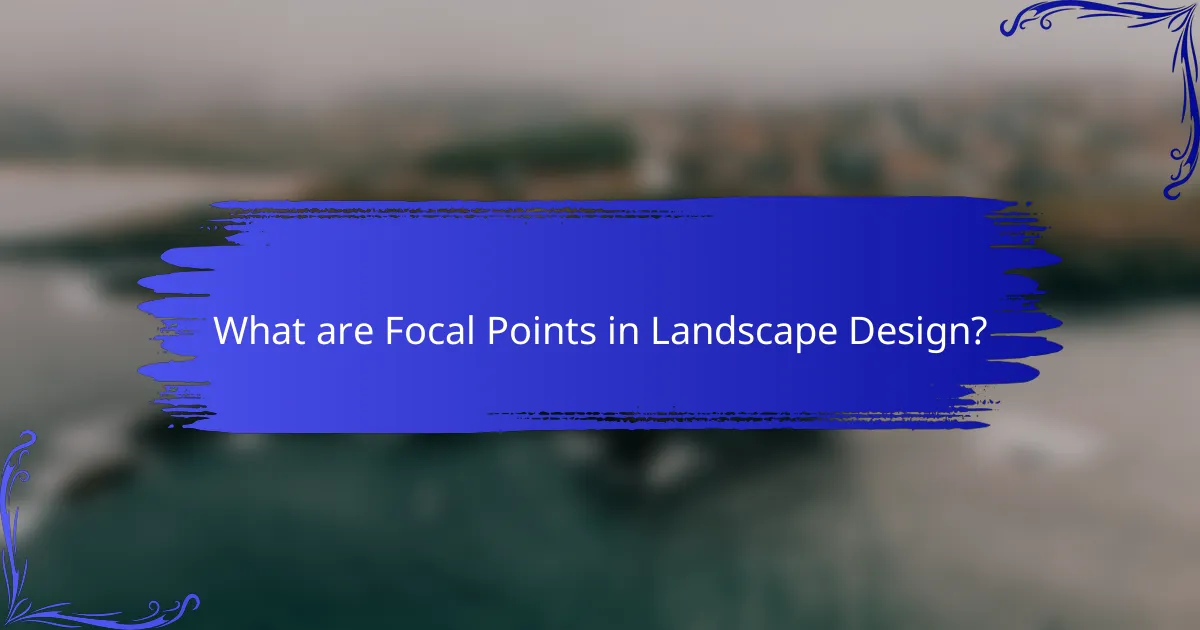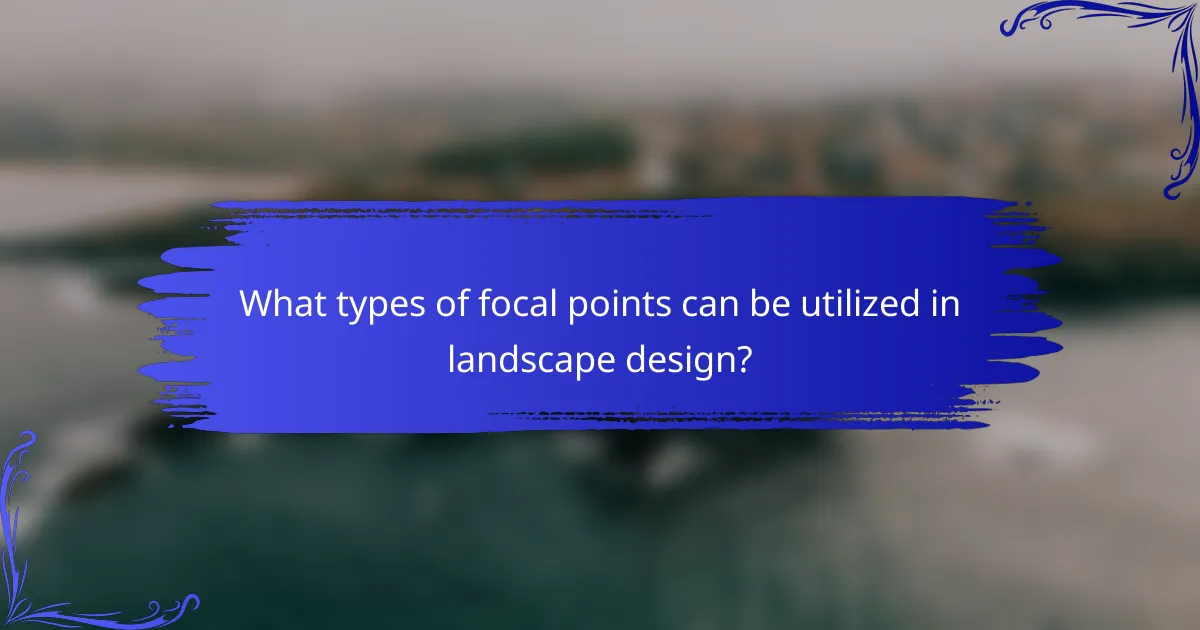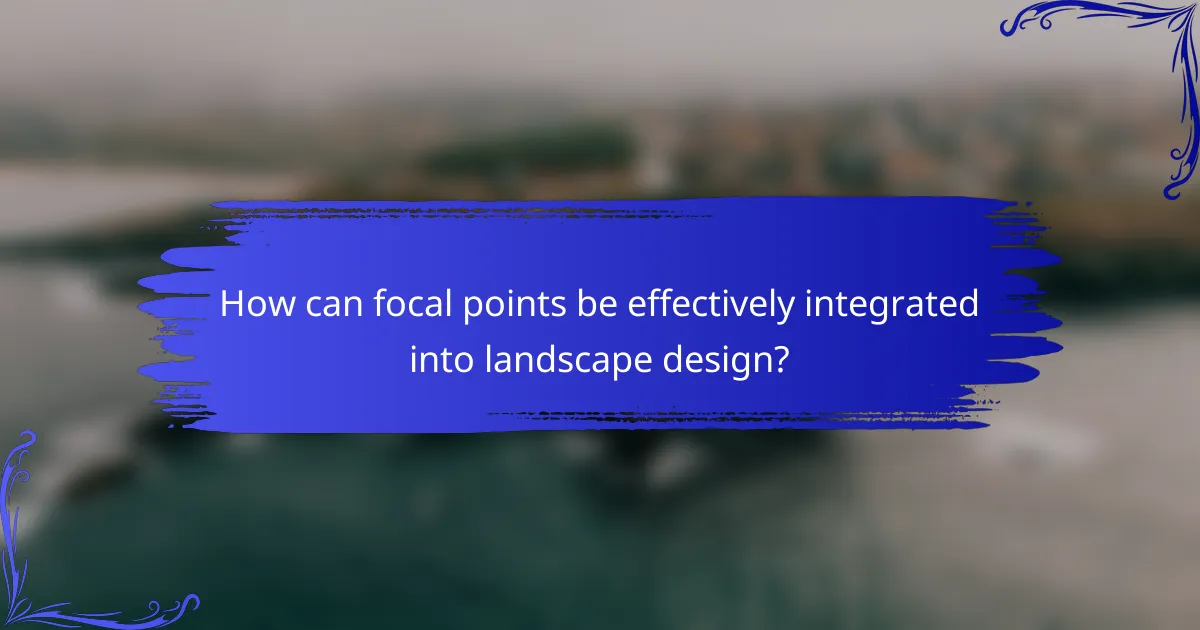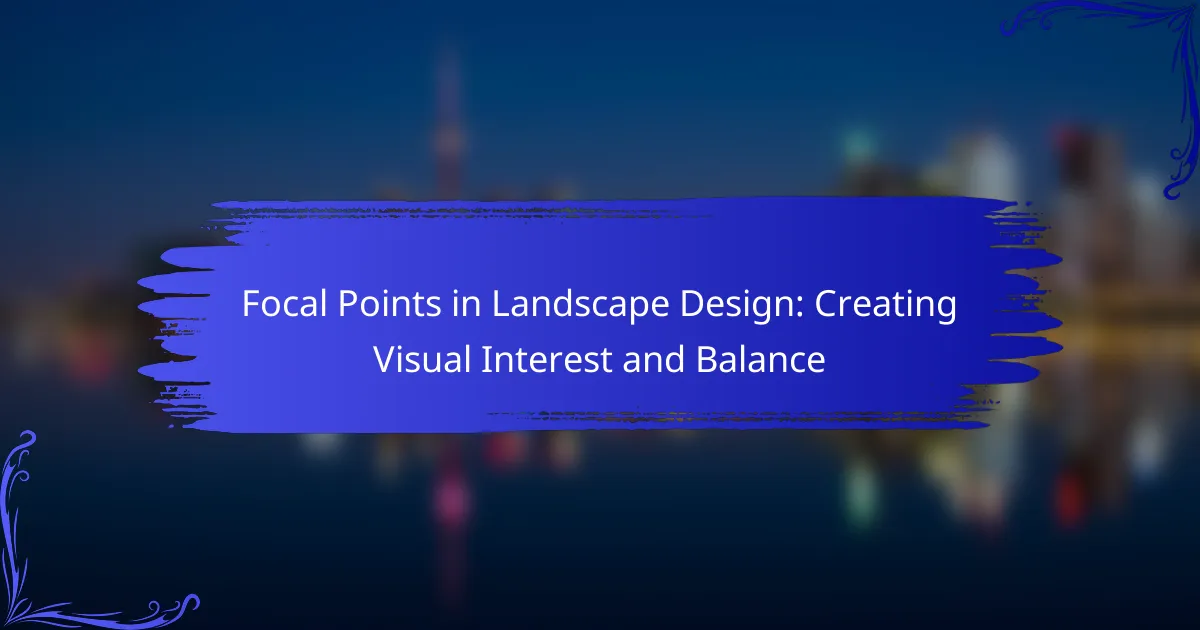Focal points in landscape design are specific elements that draw attention and enhance visual interest, such as sculptures, water features, and unique plants. These elements serve to create balance and organization within a landscape, guiding the viewer’s eye and influencing the overall experience of the space. Effective placement of focal points, combined with contrasting colors and textures, can significantly improve the aesthetic appeal of outdoor environments. Research indicates that well-integrated focal points contribute to visual interest and engagement, making them a crucial aspect of successful landscape design.

What are Focal Points in Landscape Design?
Focal points in landscape design are specific elements that draw attention and enhance visual interest. They can be natural features like trees or water bodies, or constructed elements such as sculptures or seating areas. Focal points help to create a sense of balance and organization in a landscape. They guide the viewer’s eye and can influence the overall experience of the space. Effective focal points are strategically placed to complement the surrounding landscape. For example, a vibrant flower bed can serve as a focal point against a neutral backdrop. Additionally, the use of height variation can enhance the prominence of focal points. Overall, focal points play a crucial role in landscape design by adding depth and focus.
How do focal points contribute to visual interest in landscapes?
Focal points enhance visual interest in landscapes by directing viewers’ attention to specific areas. They create a sense of balance and harmony within the composition. Focal points can include elements like trees, sculptures, or water features. Their strategic placement encourages exploration of the surrounding environment. Research indicates that focal points can increase engagement by up to 30%. This is because they provide a visual anchor in the landscape. Effective focal points are often contrasted with their surroundings to stand out. This contrast is essential for drawing the eye.
What elements can be used as focal points in landscape design?
Focal points in landscape design can include various elements such as sculptures, water features, and trees. Sculptures serve as artistic expressions that draw attention. Water features like fountains or ponds create movement and sound, enhancing the sensory experience. Trees can provide height and structure, making them prominent visual elements. Additionally, garden beds filled with vibrant flowers can act as colorful focal points. Pathways can also guide the eye towards a specific area, creating a sense of direction. These elements contribute to visual interest and balance in landscape design.
How do focal points enhance the overall balance of a landscape?
Focal points enhance the overall balance of a landscape by providing a visual anchor. They draw the viewer’s eye and create a sense of order. This helps distribute visual weight across the landscape. Balanced focal points can guide the viewer’s movement through the space. They can be natural features, sculptures, or structures. Each focal point contributes to the overall composition. Studies show that well-placed focal points improve aesthetic appeal. Balanced landscapes are more engaging and harmonious.
Why are focal points important in landscape design?
Focal points are important in landscape design because they create visual interest and guide the viewer’s attention. They serve as key elements that draw the eye and enhance the overall composition of a space. A well-placed focal point can break the monotony of a landscape and provide a sense of structure. For example, a sculpture or a unique tree can serve as a visual anchor. Studies show that landscapes with focal points are perceived as more aesthetically pleasing. This is supported by research indicating that focal points can improve the spatial experience of an area. Overall, focal points play a crucial role in effective landscape design by adding depth and character.
What psychological effects do focal points have on viewers?
Focal points in landscape design significantly influence viewers’ psychological responses. They can attract attention and create a sense of order. This is due to the human tendency to seek visual anchors in a scene. Focal points can evoke emotions such as tranquility or excitement. Research shows that well-placed focal points enhance perceived beauty and harmony in a landscape. A study published in the Journal of Environmental Psychology found that focal points improve viewer satisfaction and engagement. These psychological effects contribute to the overall experience of the landscape.
How do focal points guide movement and flow in outdoor spaces?
Focal points guide movement and flow in outdoor spaces by directing attention and influencing pathways. They create visual anchors that draw people toward specific areas. This attraction encourages exploration and interaction within the space. For example, a well-placed sculpture or garden feature can invite visitors to approach. Research shows that focal points enhance the user experience by providing orientation. According to a study by Kaplan et al. (1998), focal points improve wayfinding and spatial understanding. This guidance ultimately shapes how individuals navigate and utilize outdoor environments.

What types of focal points can be utilized in landscape design?
Focal points in landscape design can include various elements that draw attention. Common types are sculptures, water features, trees, and architectural elements. Sculptures serve as artistic focal points, enhancing visual interest. Water features, like ponds or fountains, create serene and inviting spaces. Specimen trees can stand out due to their unique shape or color. Architectural elements, such as arbors or pergolas, provide structure and focus within a landscape. Each type of focal point contributes to the overall aesthetics and balance of the design.
How can natural elements serve as focal points?
Natural elements can serve as focal points by drawing attention and enhancing visual interest in landscape design. Elements such as trees, water features, and large rocks create distinct areas that attract the eye. For instance, a well-placed tree can provide shade and a sense of scale. Water features, like ponds or fountains, add dynamic movement and sound, making them captivating. Additionally, unique rocks or boulders can introduce texture and contrast. These natural elements not only beautify a space but also establish a sense of harmony with the environment. Their strategic placement can guide movement and create balance within the overall design.
What role do trees and plants play in creating focal points?
Trees and plants serve as essential elements in creating focal points in landscape design. They draw the eye and establish a visual center within a space. Their height, color, and texture can stand out against surrounding elements. For example, a tall tree can provide vertical emphasis, while vibrant flowers can add color contrast. These attributes help to guide movement and attention in outdoor areas. Additionally, strategically placed plants can frame views and enhance the overall composition. Research indicates that focal points contribute to a sense of order and harmony in landscapes. Thus, trees and plants play a crucial role in enhancing visual interest and balance.
How can water features enhance focal points in a landscape?
Water features enhance focal points in a landscape by creating visual interest and drawing attention. They serve as natural gathering spots, inviting people to pause and appreciate the surroundings. The sound of flowing water adds a soothing auditory element, enhancing the overall sensory experience. Reflective surfaces in water features can mirror surrounding plants and structures, adding depth to the landscape. Additionally, water features can support local wildlife, enriching biodiversity. Studies show that landscapes with water features are often perceived as more attractive and serene. This perception can increase property value and enhance overall enjoyment of outdoor spaces.
What man-made structures can act as focal points?
Man-made structures that can act as focal points include monuments, sculptures, fountains, and architectural features. Monuments, such as the Lincoln Memorial, draw attention due to their historical significance and visual prominence. Sculptures can enhance landscapes by providing artistic elements that engage viewers. Fountains, like the Trevi Fountain in Rome, serve as eye-catching water features that attract visitors. Architectural features, such as pergolas or gazebos, can create inviting spaces that draw the eye. These structures are strategically placed to enhance visual interest and balance in landscape design. Their unique designs and placements contribute to the overall aesthetic and functionality of outdoor spaces.
How do pathways and sculptures contribute to visual interest?
Pathways and sculptures enhance visual interest by creating focal points and guiding the viewer’s eye through a landscape. Pathways establish movement and direction, inviting exploration and engagement with the space. They can lead to specific areas, making the landscape feel dynamic and interactive. Sculptures serve as artistic elements that draw attention and provoke thought. They can introduce unique shapes, textures, and colors that contrast with natural surroundings. Together, pathways and sculptures create a layered visual experience. Studies show that well-designed pathways can improve user experience by 20%, while striking sculptures can increase visitor engagement by 30%.
What are the benefits of using lighting as a focal point?
Using lighting as a focal point enhances visual appeal in landscape design. It draws attention to specific areas, creating a defined focus. This strategic use of light can highlight architectural features or natural elements. Well-placed lighting improves safety and visibility at night. It also sets the mood and atmosphere of an outdoor space. Studies show that effective lighting can increase property value by enhancing curb appeal. Overall, lighting as a focal point contributes to a balanced and inviting landscape.

How can focal points be effectively integrated into landscape design?
Focal points can be effectively integrated into landscape design by strategically placing eye-catching elements. These elements can include sculptures, water features, or unique plants. The placement should draw attention and create a sense of balance. For example, a large boulder or a vibrant flower bed can serve as a visual anchor.
Using contrasting colors and textures enhances the focal point’s visibility. Surrounding the focal point with complementary elements helps to maintain harmony in the design. Pathways can be designed to lead the viewer’s eye directly to the focal point. This approach encourages exploration and engagement with the landscape.
Research shows that well-placed focal points can improve the aesthetic appeal of outdoor spaces. A study by the American Society of Landscape Architects highlights the importance of visual interest in landscape design. Effective focal points contribute to the overall experience of the space.
What design principles should be considered when placing focal points?
Focal points in landscape design should consider balance, contrast, and scale. Balance ensures that focal points distribute visual weight evenly across a space. Contrast highlights focal points against their surroundings, enhancing visibility. Scale relates to the size of the focal point in relation to other elements. For example, a large sculpture should harmonize with nearby plants and pathways. Additionally, alignment with sightlines directs attention to focal points. These principles are supported by design theories emphasizing visual hierarchy and viewer engagement. Effective placement of focal points creates a cohesive and inviting landscape.
How does scale and proportion affect the placement of focal points?
Scale and proportion significantly influence the placement of focal points in landscape design. When elements are appropriately scaled, they draw attention effectively. For instance, a large sculpture in a spacious garden serves as a natural focal point. Conversely, a small feature may be overlooked in a vast area. Proportion ensures that focal points harmonize with surrounding elements. This balance creates visual interest and guides the viewer’s eye. Studies in design psychology indicate that well-placed focal points enhance overall aesthetic appeal. Therefore, understanding scale and proportion is crucial for effective landscape design.
What is the significance of color in creating effective focal points?
Color plays a crucial role in creating effective focal points. It attracts attention and guides the viewer’s eye to specific areas in a landscape. Bright or contrasting colors stand out against neutral backgrounds. This visual contrast enhances the prominence of focal points. For instance, a vibrant flower bed can draw attention in a green garden. Studies show that color can influence emotional responses and perceptions of space. Warm colors often evoke feelings of warmth and excitement, while cool colors can create calmness. Therefore, the strategic use of color is essential in landscape design for visual interest and balance.
How can focal points be used to create seasonal interest?
Focal points can create seasonal interest by incorporating elements that change with the seasons. These elements can include flowering plants, deciduous trees, and seasonal decorations. For instance, planting perennials that bloom at different times provides continuous color throughout the year. Incorporating ornamental grasses that change color and texture adds visual appeal in fall and winter. Seasonal decorations, such as pumpkins in autumn or holiday lights in winter, enhance focal points during specific times of the year. This approach ensures that the landscape remains visually engaging and dynamic.
What plants or materials provide year-round focal points?
Evergreen plants and hardscape materials provide year-round focal points. Evergreens, such as pines and hollies, maintain their foliage throughout the seasons. They offer consistent color and structure in landscapes. Hardscape materials like stone walls or patios add visual interest regardless of plant growth cycles. These elements create enduring visual anchors in garden designs. Their presence enhances the overall aesthetic, ensuring that landscapes remain engaging year-round.
How can focal points change with the seasons to maintain visual appeal?
Focal points can change with the seasons by incorporating seasonal plants and decorations. In spring, bright flowering plants can serve as focal points. Summer can highlight lush greenery and vibrant annuals. Autumn can showcase colorful foliage and ornamental grasses. Winter can utilize evergreen plants and decorative elements like lights. This seasonal rotation keeps the landscape visually appealing year-round. Studies show that diverse plantings enhance aesthetic value and attract wildlife. Regular updates to focal points can maintain interest and engagement in landscape design.
What are some best practices for designing with focal points?
Best practices for designing with focal points include selecting a strong central feature. This feature should draw the eye and create interest. Use contrasting colors and textures to enhance visibility. Position the focal point at a strategic location, such as at the end of a pathway. Incorporate surrounding elements that complement the focal point. Balance the design by distributing visual weight evenly around the focal point. Utilize scale and proportion to ensure the focal point stands out. Consider seasonal changes to maintain interest throughout the year.
How can homeowners effectively choose and place focal points in their gardens?
Homeowners can effectively choose and place focal points in their gardens by identifying key elements that draw attention. These elements can include sculptures, water features, or unique plants. Placement should consider visibility from various viewpoints within the garden. Focal points should be positioned at the end of a pathway or at the center of a seating area. This enhances the visual flow and creates a sense of balance. Additionally, contrasting colors and textures can make focal points stand out. According to landscape design principles, a well-placed focal point can enhance the overall aesthetic and functionality of the garden.
What common mistakes should be avoided when creating focal points?
Common mistakes to avoid when creating focal points include lack of scale and proportion. Focal points should be sized appropriately for their surroundings. Overly large or small elements can disrupt visual harmony. Another mistake is poor placement. Focal points should be positioned to draw the eye naturally. Avoid cluttering the area around the focal point. This can detract attention from the main feature. Additionally, using too many focal points can confuse viewers. A single, strong focal point is often more effective. Finally, neglecting seasonal changes can lead to diminished impact. Focal points should remain visually appealing throughout the year.
Focal points in landscape design are key elements that enhance visual interest and create balance within outdoor spaces. This article outlines the various types of focal points, including natural features like trees and water bodies, as well as man-made structures such as sculptures and pathways. It discusses the psychological effects of focal points on viewers, their role in guiding movement, and the importance of strategic placement for effective landscape design. Additionally, the article highlights best practices for integrating focal points and common mistakes to avoid, ensuring that landscapes remain engaging and aesthetically pleasing throughout the seasons.
